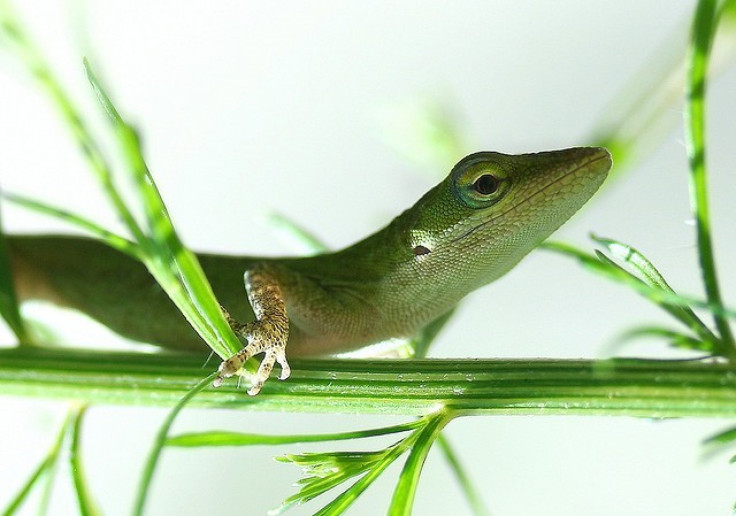First Lizard Genome Sequenced, Promising Understanding of Human Evolution

Researchers at the Broad Institute of MIT and Harvard in Cambridge, Mass., tapped into the relatively unexplored genetic landscape of reptiles and have managed to produce the first genome sequence of a lizard.
The green anole lizard, also known as Anolis carolinensis, is described as an agile and active creature. It is the first non-bird species of reptile to have its genome sequenced and assembled. The lizard is a native of the Southeastern United States.
Sometimes you need to be at a certain distance in order to learn about how the human genome evolved, said Jessica Alföldi, co-first author of the paper and a research scientist in the vertebrate genome biology group at the Broad Institute. You have to look out further than you were looking previously.
Researchers said the genomic agility and other new clues have emerged from the full sequencing of the lizard's genome and it may offer some insight into how the genomes of humans, mammals, and other reptiles have evolved.
The findings are reported online in the Aug. 31 issue of the journal Nature.
Mammals and reptiles parted ways around 320 million years ago.
A press release on the new study stated that Broad researchers have assembled and analyzed more than 20 mammalian genomes to include those of some of our closest relatives. However, the genetic makeup of reptiles needed deeper exploration.
People have been sequencing animals from different parts of the vertebrate tree, but lizards had not been previously sampled, said Kerstin Lindblad-Toh, scientific director of vertebrate genome biology at the Broad and senior author of the Nature paper, in a statement. This was an important branch to look at.
Lizards are said to be more closely related to birds than to any of the other organisms whose genomes have been sequenced in full. And like mammals, birds and lizards are amniotes. This means they aren't restricted to laying eggs in water.
A model for studying eveolution
Researchers said about 400 species of anole lizards have fanned out across the islands of the Caribbean, North America, Central America, and South America. This has made them an appealing model for studying evolution.
Researchers do know a lot about the biology and behavior of these lizards. However, their genomic information is said to may have been a critical missing piece for understanding how the lizards became so diverse.
Anoles are rich in ecology and morphology and have just the right amount of diversity to make them interesting yet tractable to study, said Jonathan Losos, an author of the paper and professor at Harvard University.
Losos is also an author of the book Lizards in an Evolutionary Tree: Ecology and Adaptive Radiation of Anoles.
But a big stumbling block in studying them has been that they have not been great organisms for classical genetic study, Losos added. The genome is going to revolutionize our ability to study that aspect of their evolutionary diversification.
The team found the sex chromosomes of the lizard, which is something researchers were only able to hypothesize about in the past.
Like mammals, green anoles seem to have XX and XY chromosomes. However, in birds males have two identical sex chromosomes called ZZ and females have two different ones known as ZW.
The lizard's X chromosome turned out to be one of its many microchromosomes.
This work represents a partnership between biologists and computational biologists, said Federica Di Palma, a co-first author of the paper and assistant director of the Broad's vertebrate genome biology group. We were able to leverage all of these views to gain insight into genome evolution in general.
By sampling the genomes of more than 90 species, the researchers were able to make a preliminary map of how these species evolved to colonize the islands they inhabit. The researchers were also able to create a parts list of proteins found in green anole eggs. They then compared that with those found in eggs from chickens and found that both bird and lizard egg genes are evolving rapidly.
Researchers also found many genes in the anoles genome that's associated with color vision. Anoles rely on this to identify choice mates.
Anoles have extremely good color vision - some species can even see in the ultraviolet range, Losos said.
Question answered
Researchers said one of the questions this newly sequenced genome may help resolve has to do with the origin of conserved, non-coding elements in the human genome.
These regions don't have protein-coding genes but are thought to have critical roles since they have remained unchanged for millennia. They said in humans, many of these so called jumping genes have lost their jumping ability, but in anole lizards, they continue to hop.
Anoles have a living library of transposable elements, said Alföldi. In anoles, these transposons are still hopping around, but evolution has used them for its own purposes, turning them into something functional in humans.
© Copyright IBTimes 2024. All rights reserved.












